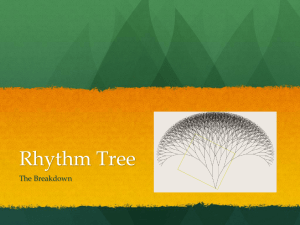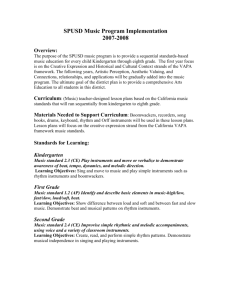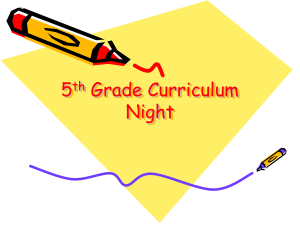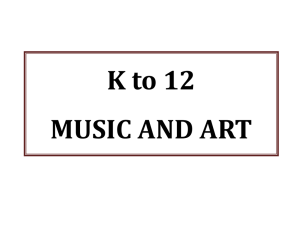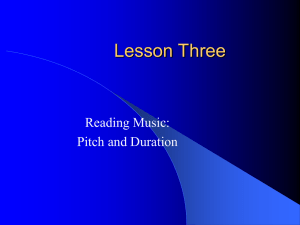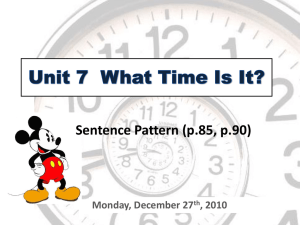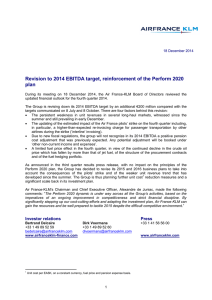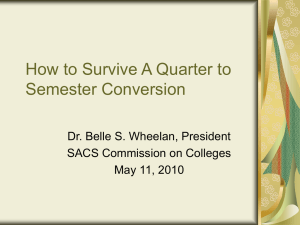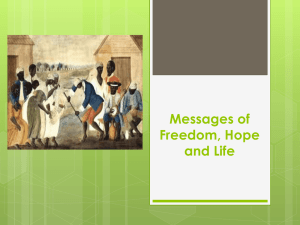Showing Student Growth - Arts Education
advertisement
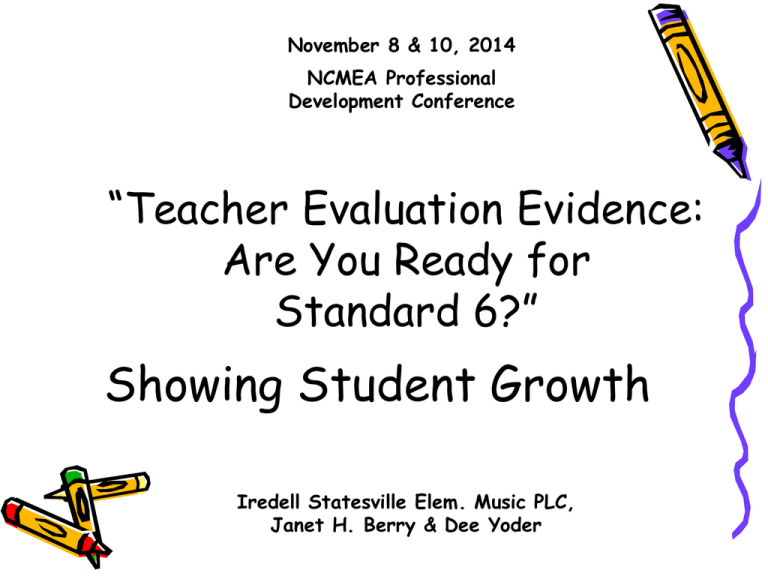
November 8 & 10, 2014 NCMEA Professional Development Conference “Teacher Evaluation Evidence: Are You Ready for Standard 6?” Showing Student Growth Iredell Statesville Elem. Music PLC, Janet H. Berry & Dee Yoder NC Educator Evaluation System Overview of Standard 6: Effectiveness Status http://ncasw.ncdpi.wikispaces.net/ NC Educator Evaluation System Analysis of Student Work Process In the ASW process, teachers: TA 1 •Describe teaching context and choose five Objectives TA 2 (3 for 2014-2015) •Compile a Timelapse Artifact for each Objective •Complete and upload an Evidence Collection •Submit the Evidence Collection for “blind” review •Receive a category rating for Standard 6 TA 3 EVIDENCE COLLECTION # of evidences may vary depending on whole vs. individual submissions 2 Work Samples TA 4 TA 5 2 Work Samples 2 Work Samples 2 Work Samples 2 Work Samples Analyzing Student Work to Change Teacher Practice Teachers: • Identify and choose a single objective? • Tie their Timelapse Artifact to the objective? • Explain how student growth is illustrated in relationship to the objective? For more information and online modules: http://ncasw.ncdpi.wikispaces.net/ Contacts at DPI: Analyzing Student Work to Change Teacher Practice Curriculum & Instruction Division NCDPI Updates; Standards, ASW & More Monday session: 5:00-6:30 in Hearn Ballroom Christie Lynch Ebert, Arts Education Consultant Dance & Music Christie.LynchEbert@dpi.nc.gov or 919-807-3856 Slater Mapp, Arts Education Consultant Theatre & Visual Arts Slater.Mapp@dpi.nc.gov or 919-807-3758 Essential Standards and RBT Arts Education Wikihttp://ances.ncdpi.wikispaces.net/ Revised Bloom’s Taxonomy Verbs How Do I Show Evidence of Student Growth – Documenting what we already do… Ideas for places to go for assessments and ideas: Pinterest ISS Elementary Music Wiki Assessment tools - Kahoot Smart Response Clickers Quizstar Socrative Nearpod InfuseLearning Authentic Assessment Toolbox RubiStar Teacher Pay Teacher Your text book adoption series Create your own! K-1, 2 Alignment examples K. ML.1.1 Exemplify (1st-Use)(2nd-Apply problem solving strategies to improve) proper technique when singing and playing a variety of music. (Horizontal) Vertical Alignment of Clarifying Objectives K-1, 2 Alignment example K. ML.1.2 - Use accurate pitch to imitate two-pitch melodic patterns.(1st- imitate, three-pitch)(2nd-sing, three-pitch) Video ● To access Video links in this presentation, you must enter “ncmea” as the password. K. ML.1.3 Execute simple rhythms using body, instruments, or voice. (1st-execute rhythm patterns) (2nd-execute extended rhythm patterns). K. ML.1.4 Recognize how music changes (such as dynamics and tempo). (1st-Apply changes in dynamics and tempo when singing and playing). K.ML.2.1 Interpret iconic symbols for rhythms. (1sticonic or standard notation for quarter notes, quarter rests and beamed eighth notes. (2nd-standard notation for half and quarter notes, half and quarter rests and beamed eighth notes. Student reads and says: titi titi ta sh K.ML.2.2 Recognize iconic symbols for at least two different pitches. Video K.ML.2.3 Recognize by sound quarter notes and quarter rest durations. Dictation using popsicle sticks or apples or snowmen with symbols. Photo of apples or Snowmen. Recommend that you record your examples so that it is truly just the sound. Smartboard. K.MR.1.2 Recognize contrasts in music, such as high/low pitch, loud/soft dynamics, fast/slow tempo, and same/different sections of music. 1st Grade 1.ML2.1 Video Interpret rhythm patterns that use iconic or standard notation for quarter notes, quarter rests and beamed eighth notes. 1.ML.3.3 Use iconic notation to compose simple rhythm patterns consisting of quarter notes, beamed eighth notes, and quarter rest durations. 1.MR.1.2 Recognize melodic patterns, rhythmic patterns, dynamics, and forms when presented aurally. Apple Rhythms PPT Created by D. Brian Weese (Aural Dictation) 2.ML.1.3 Execute extended rhythm patterns using body, instruments or voice. Video 2.ML.2.2 Interpret 3 pitch songs with voice and instruments. Video 2.ML.2.3 Use standard notation to notate half and quarter notes, half and quarter rests, and beamed eighth notes. Rhythm Boards Or other notation for upper grades 2. ML3.3 Create rhythm patterns using half and quarter notes, half and quarter rests, and beamed eighth notes in duple and triple meter. 3rd Grade 3. ML.2.1 Interpret rhythm patterns, including notes and rests in 3/4 and 4/4 meter signatures. Have these for the students to choose whichever meter you are working on. Have them perform them. Be sure to video!! 3.ML.3.1 Use improvisation to create rhythmic and melodic ostinato accompaniments. Dinah MusicPlay, 3rd Grade Denise Gagne www.musicplay.ca Theme & Variations 3. ML.3.3 Create rhythmic compositions using whole, half, and quarter notes; half and quarter rests; and beamed eighth notes in duple or triple time. 4th Grade 4.ML.2.1 Interpret rhythm patterns, including whole, half, dotted half, quarter, and eighth notes and rests in 2/4, 3/4, and 4/4 meter signatures. (These programs can generate individual scores) www.smartmusic.com www.musiclearningcommunity.com Music Ace 4.ML2.2 Interpret through voice and/or instruments simple pitch notation in the treble clef in major keys. Music Ace Scores Recorder Rubric Assessment MR 1.3 Design a set of criteria for evaluating music performances and compositions. 4.MR.1.4 4th Grade Classify instruments into Western orchestral categories of wind, string, percussion, and brass. 5th Grade 5.ML.1.3 Use instruments to perform rhythmic, melodic, and chordal patterns accurately and independently on classroom rhythmic, melodic, and harmonic instruments. This Land is Your Land (Easy as 123 Book, p5 Melody) Oh, Suzanna (Easy as 123 Book, p11 3 strings) Clementine (Easy as 123 Book, p27- I, V7 chords) California (I, IV, V7 chords) Shady Grove (Melody, Drones, Singing) 5.ML.1.3 Video Use instruments to perform rhythmic, melodic, and chordal patterns accurately and independently on classroom rhythmic, melodic, and harmonic instruments. 5. ML.2.2 Recognize pitches on the treble and bass staves, including ledger lines, in order to understand the continuum of standard pitch notation. L to J Quick 5 each week. 5. ML 2.4 Use standard symbols to notate rhythm, meter, pitch, and dynamics. 5. MR 1.3 Exemplify appropriate behaviors as a participant and observer of music in relation to the context and style of music performed. 1. Entering 2.Sitting 3.Participation 4.Attention 5.Appreciation 1 I occasionally show appropriate behaviors as a participant/ observer in relation to context and style of music performed. 2 I mostly show appropriate behaviors as a participant/ observer in relation to context and style of music performed. 3 I always show appropriate behaviors as a participant/ observer in relation to context and style of music performed. http://rubistar.4teachers.org/index.php ISS 5th Grade Assessment http://quizstar.4teachers.org/ Code: QI_DEGGGJ Data Evidence From NAfME Janet H. Berry jberry@iss.k12.nc.us http://www.isselementarymusic.pbworks.com Dee Yoder dyoder@burke.k12.nc.us
